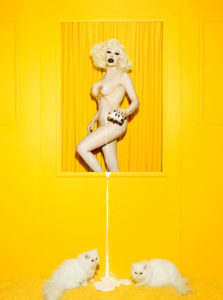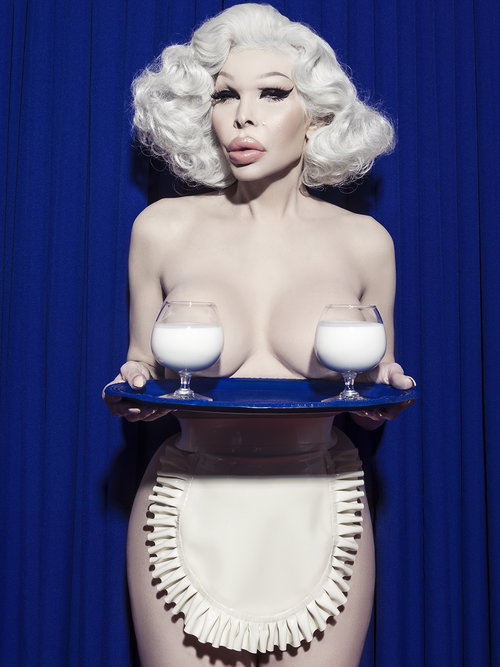Well known as a fashion photographer, Vijat Mohindra has made a career of photographing artsy spreads and celebrity fashion shoots for glossy magazines. He is known also as a chronicler of pop-imp/provocateur Miley Cyrus. His perspective in “Always Believe that Something Wonderful is About to Happen,” his debut international solo exhibition, is influenced by his pop/fashion work and is unapologetically commercial, plastic, image-conscious and full of artifice.
Each of his C-prints (all works 2016) features women, some anonymous, while others, like Amazon Ashley, who, at 6-foot-7 calls herself the world’s tallest stripper, and trans/queer icon Amanda Lepore, are minor celebrities. Mohindra’s staged photos trade in images that alternately, or even concomitantly, reinforce and contravene old, established gender roles; in addition, he takes as his subject the uncanny, producing surreal and sci-fi themed tableau. With works scaled to the human figure, the effect is encompassing and, with some at nearly 7-feet vertically, at times, larger than life.
The uncanniness of Mohindra’s photographs—much like the portrayal of Data as the next-generation Spock in the television show Star Trek: The Next Generation (1987–1994), with his synthetic blue-hued skin—articulates a vision of person as simulacrum. Milkeyway, a close-up of one of his models, reveals a visage that teeters ambiguously between bio and manufactured.

Vijat Mohindra, from exhibition “Always Believe that Something Wonderful is About to Happen”, 2016
Blue Dream, a photo of the same red-haired model, now splayed out on an impossibly blue carpet, her fair skin covered in a glistening sheen, cultivates an oddly inorganic appearance, as if she were a doll or mannequin, more android than human. Yet, the piece may be far more somatic. The title shares its name with a genetically hybrid strain of cannabis that produces the kind of effect staged in Mohindra’s photograph.
For all Mohindra’s futurism—for example, Space Bubble, which evokes a lunar-like sci-fi landscape—he furnishes his photographs with details that infuse them with a twinge of nostalgia (he also readily recycles sets from fashion shoots). Cake, a picture of Amanda Lepore holding a heart-shaped cake, is set in front of the kind of painted red wood paneling one might find in a 1960s ranch house—it is also the backdrop from a fashion shoot.
Lepore is the main example of Mohindra’s engagement with the symbols of gender, and the image is laden with cultural baggage. In this photograph, she is adorned only in pasties made with butter frosting topped with deliciously tumescent cherries. The cake that she gently tilts forward for the viewer’s pleasure is far too small for her to jump out of, yet it is allusive just the same. Her surgically accentuated features adhere to a particular idealized vision of femininity. Mohindra’s dispensation with naturalism, as noted by critic Evan Moffit in the exhibition essay, constructs the individual as a product of the processes of the digital age, not only of language, but of technology.
Lepore’s reconstruction of a self after a certain fashion is reminiscent of French artist Orlan’s relentless pursuit of aesthetic ideals based on art historical examples, embodied in her features through repeated surgical interventions. Mohindra’s gravitation toward Lepore and other women as models for contesting gender can be compelling, but at times feels too reliant on the language of fashion to delve beyond the surface.



















0 Comments